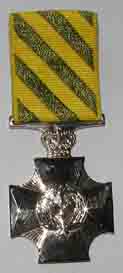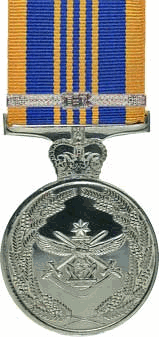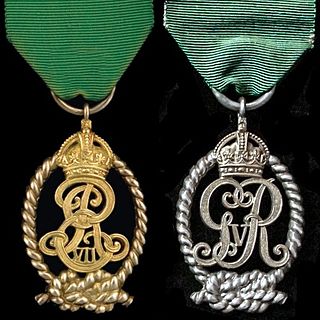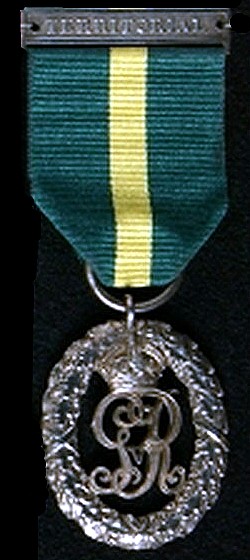The Australian honours and awards system refers to all orders, decorations, and medals, as instituted by letters patent from the Monarch of Australia and countersigned by the Australian prime minister at the time, that have been progressively introduced since 14 February 1975. The Australian honours and awards system excludes all state and local government, and private, issued awards and medals.
The Canadian Forces' Decoration is a Canadian award bestowed upon members of the Canadian Armed Forces who have completed twelve years of military service, with certain conditions. By convention, it is also given to the governor general of Canada upon his or her appointment, which includes the title of Commander-in-Chief in and over Canada. The decoration is awarded to all ranks, who must have a good record of conduct during the final eight years of claimed service.

The Conspicuous Service Cross (CSC) is a decoration (medal) of the Australian honours system. It is awarded to members of the Australian Defence Force "for outstanding devotion to duty or outstanding achievement in the application of exceptional skills, judgment or dedication, in non-warlike situations". In November 2019, 1129 people were listed as recipients. All ranks are eligible for the award.
The Distinguished Service Cross (DSC) is a military decoration awarded to personnel of the Australian Defence Force. It is awarded for distinguished command and leadership in action. The DSC was introduced in 1991 and is the highest distinguished service decoration in the Australian Honours System. Recipients of the Distinguished Service Cross are entitled to use the post-nominal letters "DSC". Since its inception 115 awards have been made—which includes eight first Bars and one second Bar.
The Star of Gallantry (SG) is a military decoration awarded to personnel of the Australian Defence Force (ADF) and other persons recognised by the Minister for Defence. It is awarded for acts of great heroism or conspicuous gallantry in action in circumstances of great peril. It is the second highest of the military gallantry awards in the Australian Honours System, only surpassed by the Victoria Cross or Victoria Cross for Australia (VC).
The Medal for Gallantry(MG) is a military decoration awarded to personnel of the Australian Defence Force. It recognises acts of gallantry in action in hazardous circumstances. The MG was introduced on 15 January 1991, replacing the Imperial equivalent. It is ranked third in the Gallantry Decorations in the Australian Honours System. Recipients of the Medal of Gallantry are entitled to use the post-nominal letters "MG".
The Australian Defence Medal is an Australian military decoration which recognises current and former Australian Defence Force personnel who completed an initial enlistment period, or four years' service. It was established on 20 March 2006; however, it recognises qualifying efficient service of current and former Australian Defence Force Regular and Reserve personnel, including National Servicemen, who have served since 3 September 1945. It is estimated that up to one million current and ex-serving personnel are eligible for the award. At 30 June 2010, a total of 242,576 had been awarded.

The Iraq Medal was authorised on 23 February 2004. It was a campaign medal issued to members of the British Armed Forces and certain attached personnel, who served between 20 January 2003 and 22 May 2011 on, or in support of, Operation Telic - the designation for British operations during the 2003 Invasion of Iraq and its aftermath.
The Governor-General of Australia has, at irregular intervals, notified for general information the positioning of the wearing of Australian Orders, Decorations and Medals in the Commonwealth of Australia Gazette. The Order of Wearing Australian Honours and Awards was last published in 2007, and replaced the previous list published in 2002.

The Reserve Force Decoration is an Australian Military award given for long service by officers of the Reserve Forces. It is part of the suite of defence force service awards introduced in 1982, which also included the Defence Force Service Medal and the Reserve Force Medal. However, the RFD is the only one of the three to carry a postnominal entitlement.

The Afghanistan Medal was instituted by Queen Elizabeth II, Queen of Australia on the advice of the Australian Prime Minister John Howard in 2004. It is awarded to Australian defence force personnel who served in or around Afghanistan after 11 October 2001. Defence force personnel are also recognised by the 'ICAT' clasp to the Australian Active Service Medal and the North Atlantic Treaty Organisation's Non-Article 5 Medal with 'ISAF' clasp.

The Reserve Force Medal (RFM) is an Australian Military award given for long service by non-commissioned members of the Reserve Forces. It is part of the suite of defence force service awards introduced in 1982, which also included the Defence Force Service Medal and the Reserve Force Decoration.

The Defence Long Service Medal is an Australian military award given for long service by permanent and reserve members of the Australian Defence Force (ADF), irrespective of rank. It was introduced in 1998, and replaced the suite of ADF service awards introduced in 1982, which comprised the Defence Force Service Medal, the Reserve Force Medal and the Reserve Force Decoration.

The Australian Cadet Forces Service Medal is awarded to recognise long and efficient service by officers and instructors in the Australian Defence Force Cadets. It is awarded for 15 years service. Additional clasps are issued for every 5 years additional service.

The Decoration for Officers of the Royal Naval Volunteer Reserve, post-nominal letters VD until c. 1947 and VRD thereafter, was instituted in 1908. It could be awarded to part-time commissioned officers in the United Kingdom's Royal Naval Volunteer Reserve after twenty years of service as efficient and thoroughly capable officers. The decoration was a Naval version of the Volunteer Officers' Decoration and its successor, the Territorial Decoration.

The Cadet Forces Medal is awarded to recognise long and efficient service by Commissioned Officers and non commissioned adult instructors of the UK Cadet Forces: The Army Cadet Force, the Air Training Corps, the Sea Cadet Corps, the Volunteer Cadet Corps and Combined Cadet Force, and Commissioned Officers of the New Zealand Cadet Forces. Authorised by a Royal warrant it is awarded for 12 years service or when commissioned. Additional clasps are issued for every 8 years additional service in New Zealand & for 6 additional years in the UK.

The Efficiency Decoration, post-nominal letters TD for recipients serving in the Territorial Army of the United Kingdom or ED for those serving in the Auxiliary Military Forces, was instituted in 1930 for award to part-time officers after twenty years of service as an efficient and thoroughly capable officer. The decoration superseded the Volunteer Officers' Decoration, the Colonial Auxiliary Forces Officers' Decoration and the Territorial Decoration.

The National Police Service Medal (NPSM) is a special service award within the Australian honours system to provide "recognition for the unique contribution and significant commitment of those persons who have given ethical and diligent service as a sworn member of an Australian police service".

The Royal Naval Volunteer Reserve Long Service and Good Conduct Medal, initially designated the Royal Naval Volunteer Reserve Long Service Medal, was instituted in 1908. It could be awarded to part-time ratings in the United Kingdom's Royal Naval Volunteer Reserve after twelve years of service and good conduct. The medal was a Naval version of the Volunteer Long Service Medal and its successor, the Territorial Force Efficiency Medal.












